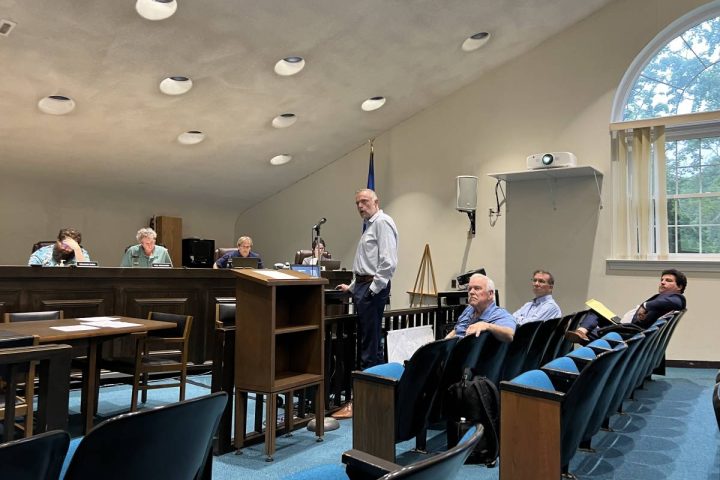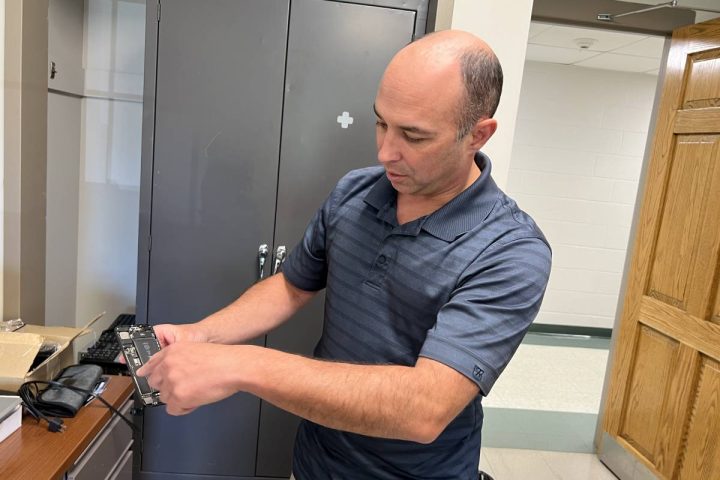On the eve before the last day of school on June 22, 1977, children enjoyed the warm weather, riding their bikes and playing with friends, while eagerly anticipating the start of summer vacation. But for one Monroe family the day ended in tragedy.
Renee Freer, 8, was bludgeoned to death in a wooded area about 300 yards from her home on Williams Drive. The case was never solved and continues to be Monroe’s only unsolved murder.
A local writer is doing research for a book to shine a spotlight on the old case, which police say is still active. Erik C. Hanson, 45, who grew up in Monroe and graduated from Masuk in 1996, is an author who published 10 books.
“What I want most is for the coward that did this to come forward,” he said of the project. “I want the coward to confess — if he’s still alive. That’s what I want more than anything.”
Lt. Kevin McKellick said the case was passed on from detective to detective over the years, as the department followed up on every new lead. When he was assigned to the detective bureau in 2018, he read the file himself.
“I familiarized myself with the Freer case, because calls come in periodically,” McKellick said during an interview in his office. “I wanted to dispel any rumors and understand what we were working with in the case.”
“The case is far too large for one person to handle, so I brought Det. Jeff Marcel onboard,” McKellick said. “He reviewed the entire case file from the start up until present day. From there we developed a plan moving forward.”
“Jeff is a seasoned detective,” McKellick added, “but he knew nothing about the Freer case in the beginning. He was a fresh set of eyes.”
Marcel is now in charge of the case. Anyone with information should call the Detective Division at 203-452-2831 and ask for him.
Posts about the Freer murder on the internet allow imaginations to run wild as online users try to connect the dots, but McKellick said not all of it is true and police cannot respond directly because it is still an open case. The lieutenant also said there is information about the case police have never released to the public.
In 1977, Gov. Ella Grasso offered a $3,000 reward to anyone providing information leading to an arrest for the murder. Then she raised it to $20,000 in 1978. In the year 2000, Gov. John Rowland raised it to $50,000, where it now stands.
Over the years, the Monroe Police Department has reached out to other law enforcement agencies for assistance in solving the case.
In 1999, police worked with the National Center for the Analysis of Violent Crimes in Quantico, Va., a unit dedicated to helping local law enforcement agencies investigate unsolved crimes. The agency had the latest forensic tools, including DNA testing, according to a Connecticut Post article dated July 5, 1999.
The Monroe Police Department is currently working on the case with the Department of Emergency Services and Public Protection’s Division of Scientific Services.
Renee goes missing
Norman Mercier, who is now retired, was the first detective in charge of the Freer case. In a phone interview, he shared some of what he remembers from that fateful day in 1977.
Felicia Freer, a single mother, lived with her parents and her two children, Renee, 8, and Nicholas, 5, in a house on Williams Drive. Parents were baking for a party to be held at Stepney Elementary School the following day.
Freer planned to make cookies and drove to the store to buy the ingredients, leaving her children home with their grandparents, Mercier recalled.
Renee went outside to play with her friends in the neighborhood around 6 p.m. That was the last time her family saw her alive.
The 1970s was an innocent time when people knew their neighbors and children played outside together for hours on end, until their parents called out for them to come home.
When Freer returned home, she began to worry about her daughter, because it was getting dark outside and Renee didn’t respond when she called out her name.
“It was a violent murder and a child was involved. Whenever you have a child involved it makes matters 10 times worse. It was something that never happened in the town of Monroe before — and it’s never happened since, so it was a shock to the whole community,” — Norman Mercier, retired Monroe police detective
According to a Bridgeport Post article published on June 23, 1977, Freer and some neighbors started searching for Renee around 8 p.m. When the search was unsuccessful, she called the police at 9:15 p.m.
Police searched the area and at 10:12 p.m. two special police officers found the little girl’s battered body in a wooded area near Hattertown Road, about 300 yards off Williams Drive. It was an area where children loved to play. She had been bludgeoned to death and officers believed a rock nearby was used as the murder weapon.
Renee was wearing a blouse and shorts and the collar of the blouse was slightly torn, but her clothing was otherwise undamaged, according to the article. An autopsy later determined she was not sexually assaulted.
“It was a violent murder and a child was involved,” Mercier said. “Whenever you have a child involved it makes matters 10 times worse. It was something that never happened in the town of Monroe before — and it’s never happened since, so it was a shock to the whole community.”
Monroe’s current police chief, Keith White, said there were three murders in Connecticut that day, so the Connecticut Office of the Chief Medical Examiner was short staffed. As a result, two of the victims had forensic autopsies and Renee had a hospital autopsy.
If she had a forensic autopsy, White said more evidence would have been preserved and could have been examined years later, when law enforcement had more advanced technology at their disposal.
He said all murder victims now receive forensic autopsies.
Family deserves closure
McKellick said people have moved over the last 47 years, everyone is getting older and some have died, making the case even more difficult to solve. Renee Freer would have been 55-years-old this year, he added.
“For the sake of Renee and her family and the investigators who tried to solve this case over the course of decades, and the townspeople who had this case on their minds over the years, we want to bring this to a resolution,” he said.
“We would all love to see it solved,” Mercier said. “She had a younger brother. I’m sure he would love some answers. The officers and the town deserve some closure. The Monroe Police Department is working on this case like nothing I’ve seen before. They’re turning every table over.”
A interest in true crime

Hanson lives in New England with his wife and their young daughter. He authored 10 books, including seven horror stories and three westerns.
Hanson had recently applied for an online criminal justice program at UMass Lowell, making friends wonder if he was changing careers, but he said it was to help him write a true crime book.
“Last year, I signed a deal to do some westerns, but I feel my writing merging towards this true crime mode based on what my interest is,” he said.
Hanson wondered if there were any unsolved murders in Monroe. “I watched ‘Dateline’ more than I want to admit,” he said with a laugh.
“Ironically, I was born one year after this happened and I heard nothing,” he said of the Freer murder, “so that’s actually what kind of shocks me. I only found out about this on March 24th of this year.”
Hanson found a Facebook post about the unsolved murder from Ken Heim, a retired Monroe police detective who was a prominent investigator on the case. Heim was actually Hanson’s first stepfather.
“I’m like, ‘can you believe this?’ I haven’t spoken to him. I saw him once in passing 10 or 15 years ago, but I haven’t talked to him, talked to him in like 30 years — if not more,” Hanson said.
Despite their connection, he said Heim could not help him with the book. “But he expressed his heartfelt wish for the case to be solved,” Hanson said.
Of pursuing the story of the Freer case, Hanson said, “it was just one of those things. The case was ambiguous and it was just rip your heart out. I haven’t been able to stop once I discovered it. I’m just trying to talk to people. The case is active. I don’t want to get in anybody’s way.”
“I’m not a detective. I’m not a journalist. I’m just a writer with an interest in criminal justice, which is happening later in life,” Hanson said. “The interest was kind of always there, but now I’m just trying to explore it.”
At a minimum, Hanson said he hopes his efforts help to spur a community conversation about the case. To that end, he started the “Who Killed Renee Freer?” Facebook page, which had 58 members as of Saturday night.
“If anybody could just join, share and not just put ‘likes’, but comments,” Hanson said. “If they feel they remember something, they should contact the Monroe Police Department.”
Though he has connections to publishers, to keep this case alive in the public eye, he said he is not opposed to self-publishing his book. No matter how the book does, Hanson said he hopes the announcement of the project and news articles around it will bring attention to the case and get somebody to come forward with information.
“I’m just trying to keep the light on,” Hanson said. “Keep the light on for Renee’s sake and her memory. But will it lead to anything? I have no idea. I just want people to talk about it, because I grew up in Monroe … without ever hearing about it.”
All respectful comments with the commenter’s first and last name are welcome.






